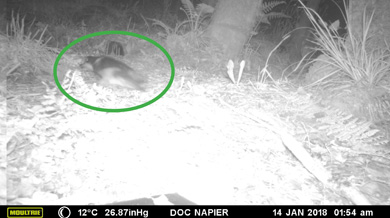Archived content: This media release was accurate on the date of publication.
Date: 27 February 2018
This news comes after the successful return of the tītī or Cook’s Petrel to the range – demonstrating such translocations are a vital tool in the restoration of ecosystems in New Zealand.

The first sighting of the Maungaharuru Range colony kōrure
The translocation programme, part of the Poutiri Ao ō Tāne project, started back in 2014 and over several translocations from Whenua Hou, an island off the coast of Rakiura/Stewart Island, almost 200 endemic kōrure travelled by plane and helicopter 1131 kilometres to their new home.
Chicks were translocated at a young age, because kōrure take a mental picture of their nest site when they emerge from the burrow for the first time. Incredibly, their nest site is where they will return to breed after 3-4 years at sea.
At 23 km from the ocean, the Maungaharuru Range sea bird translocation site is the most inland of any in New Zealand.
Department of Conservation Principal Science Advisor Graeme Taylor says this project is about restoring an ecological system missing from the North Island.
“In the past seabirds bred inland in their millions on the mountain ranges and deposited their poop (nutrients) across the landscape which provided the forest below with marine nutrients,” he says.
“The fertiliser supports plant growth and the burrows birds dig provide a home for reptiles like tuatara and various insects and plants that thrive in a nutrient enriched environment.”
Mr Taylor says originally three species nested inland – tāiko or black petrels, the kōrure and tītī.
“Returning two of these to the Maungaharuru Range is the first chance to see if seabirds can once again be part of the North Island inland ecosystems,” he says.
“Getting one bird of each species back is the start of what we hope is a return of many translocated chicks to come back and breed at this site.”
In addition to being ecologically significant, he says these translocations are part of an effort to restore seabird populations, which are culturally significant to Māori.
Tania Hopmans, Trustee for Maungaharuru-Tangitū expresses ‘our gratitude to Whenua Hou for their manaakitanga in providing us with the opportunity to rejuvenate these taonga to our Maunga.’
Poutiri Ao ō Tāne has been a great project to get us started and we thank the project partners for their mauri. We look forward to the continued collaborative efforts in the region in rejuvenating our Maunga.”
Whenua Hou Komiti Chair Tane Davis congratulated all involved saying this outcome is very satisfying.
“As chair of the Whenua Hou Komiti it is exciting news to hear the return of the first kōrure to Maungaharuru. The Whenua Hou Komiti was formed from the Ngai Tahu Settlement Act to give advice in the management of the island Whenua Hou. Kōrure are recognised as a Taonga species to Ngai Tahu Iwi, and more so to Rakiura Māori, and to have the opportunity to support the transfer of Kōrure over the past years to re-establish populations back to their original origins is very satisfying.”
The translocations are part of an effort to restore seabird populations, which are culturally significant to Māori. They’re also ecologically significant, partly because of the nutrients they deposit from the sea back into the native bush.
Further information
Kōrure
- Mottled petrel seabirds, were also found in the ranges of Hawke’s Bay, but are now only on southern offshore islands such as Whenua Hou (Codfish Island).
- Mottled petrel – unlike other translocated seabirds – have a largely krill-based diet.
Poutiri Ao ō Tāne
Poutiri Ao ō Tāne is an ecological and social restoration project. It’s located in the Maungaharuru-Tūtira catchment, 60 km north of Napier with the Boundary Stream Mainland Island at its heart. It is the sister project to Cape to City.
Poutiri Ao ō Tāne Facebook page
Contact
For media queries contact:
Email: media@doc.govt.nz
